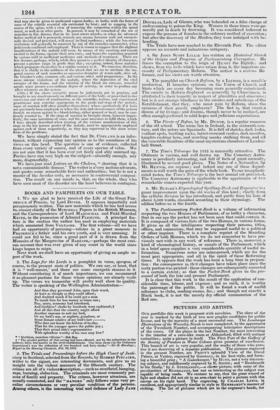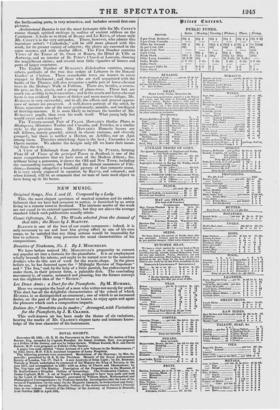PICTURES AND ARTISTS.
Oen portfolio this week is pregnant with novelties. The close of the year is marked by the birth of two new graphic candidates for public favour, and by the maturity of a most successful one. The Landscape Illustrations of the Waverlcy Novels is now completed, by the appearance of the Twentieth Number, and accompanying letterpress descriptions of the views. Of the plates in the last Number, the most interesting is the interior of a cave-like room at Abbotsford, filled with antique curiosities ; quite a picture in itself. The First Part of the Gallery of lime Society of Painters in Water Colours gives promise of excellence. This branch of art is very popular, and the works of those who prac- tise it are deserving of a separate publication. The pictures engraved in the present Number, are PROUT'S splendid View of the Ducal Palace, at Venice, engraved by GOODALL, in his best style, and form- ing a beautiful print; "A Gamekeeper," by HUNT, not a very interest- ing subject, and indifferently engraved by E. SMITH; and " Rembrandt in his Study," by J. STEBHANOFF,—a clevtr picture, with some of the peculiarities of REMBRANDT, but not so interesting as the subject was capable of being made. We venture to say, that the great wizard of light and shadow did not sit in an arm-chair to paint a picture with the canvas on his right hand. The engraving, by CHARLES LEWIS, is excellent, and appropriately similar in style to REMBRANDT'S manner of etching. The list of pictures which are in the engraver's hands, for
the forthcoming parts, is very attractive, and includes several first-rate pictures. Architectural Beauties is not the most fortunate title for Mr. CONEY'S coarse though spirited etchings in outline of ancient edifices on the Continent : it leads us to think of BLORE and LE KEUX, of whose style Mr. CONEY'S is the very antipodes. Those, however, who admire this ingenious artist's "Cathedrals," will be still more pleased with this work, for its greater variety of subjects; the plates are executed in the same manner, and with similar effect. The First Number contains Views of the Tower of St. Ouen at Rouen, the Hotel (la Ville at Antwerp, and an interior of St. Peter's Church at Louvain, showing the magnificent shrine ; and several neat little vignettes of houses and parts of larger structures.
The Eighth Number of BURGESS'S Eidodendron contains' among others, portraits of. the two fine cedars of Lebanon in the Botanic Garden at Chelsea. These remarkable trees are known to every voyager to Richmond ; and those who are well acquainted with the banes of the Thames, will also recognize a noble pair of horse-chesnut trees in the Bishop's Walk at Fulham. There are, besides, a venera- ble yew, an ilex, acacia, and a group Of plane-trees. These last are much too scribbly in their execution ; and in the acacia and horse-chesnut haste is too evident In trees of darker and more Massive foliage, Mr. BURGESS is very successful ; and in all, the effects and general appear- ance of nature are preserved. A well-drawn portrait of the artist, by Ross, represents one of the most gentlemanly, amiable, and intelligent of drawing-masters. It is more likely to increase the number of Mr. Br acEss's pupils, than even his work itself. What young lady but would covet such a teacher?
The Twenty-second Part of FRANK HOWARD'S Outline Plates to Shaltspeare_, illustrates Troilus and Cressida, and Pericles, in a similar style to the previous ones. Mr. HOWARD'S Homeric heroes are tall fellows, tamely graceful, attired in classic costume, and cleverly grouped ; but there is neither a Hector, an Achilles, nor an Ajax among them. Thersites mimicking Ajax is the best ; Cassandra is an Opera maniac. We admire the designs only till we learn their mean- ing from the text.
-A View of Edinburgh from Arthur's Seat, by PURSER, forming Plate 37 of Views of the principal Towns in Scotland, is one of the most comprehensive that we have seen of the Modern Athens ; for, without being a panorama, it shows the Old and New Town, including the surrounding country, the Firth, and the distant mountains of Fife- shire,-forming altogether a beautiful picture of that romantic scene. It is very nicely engraved in aquatint, by REEVE, and coloured ; and when framed, will be an ornament that no man of taste need object to have hung up in his house.



























 Previous page
Previous page